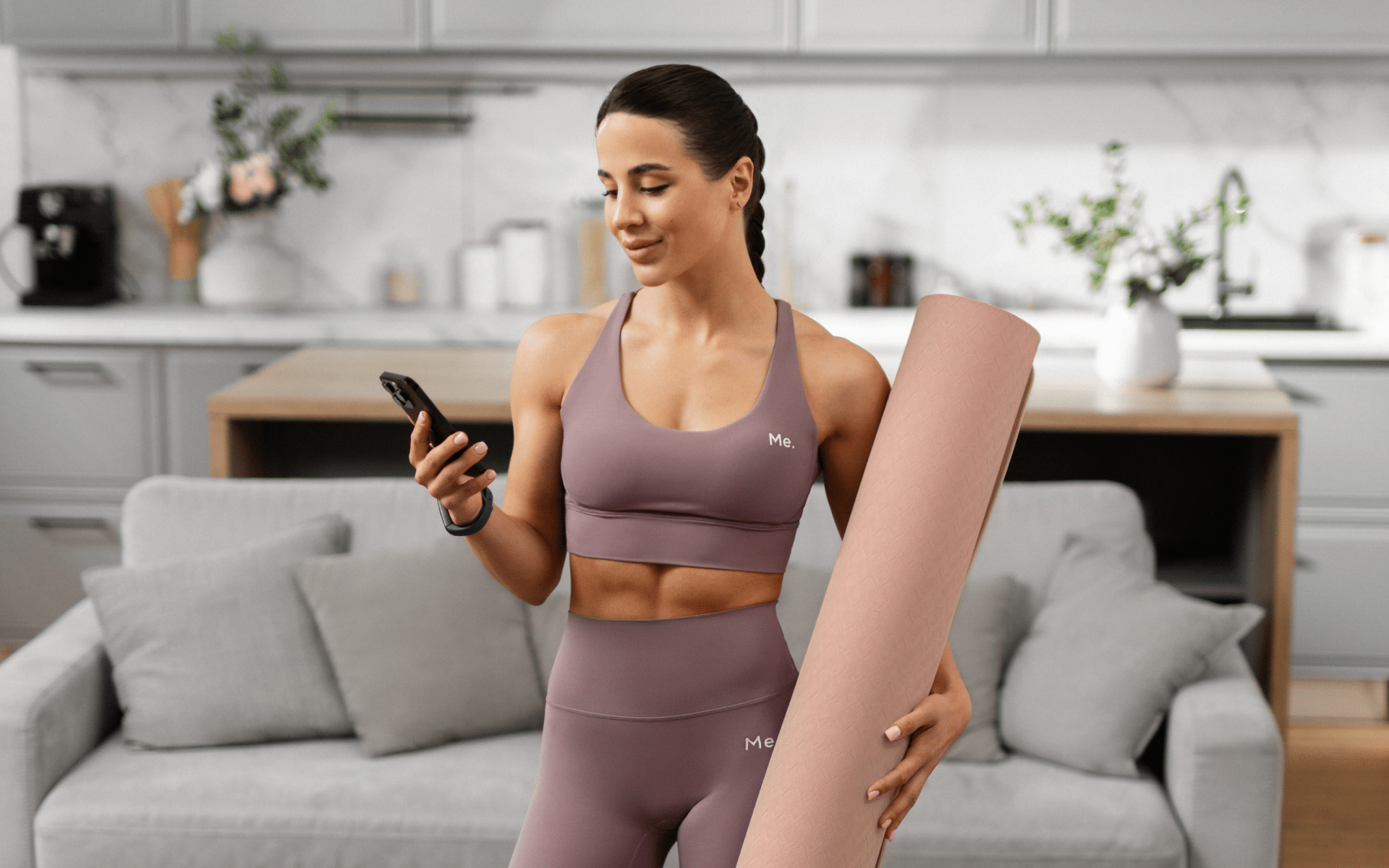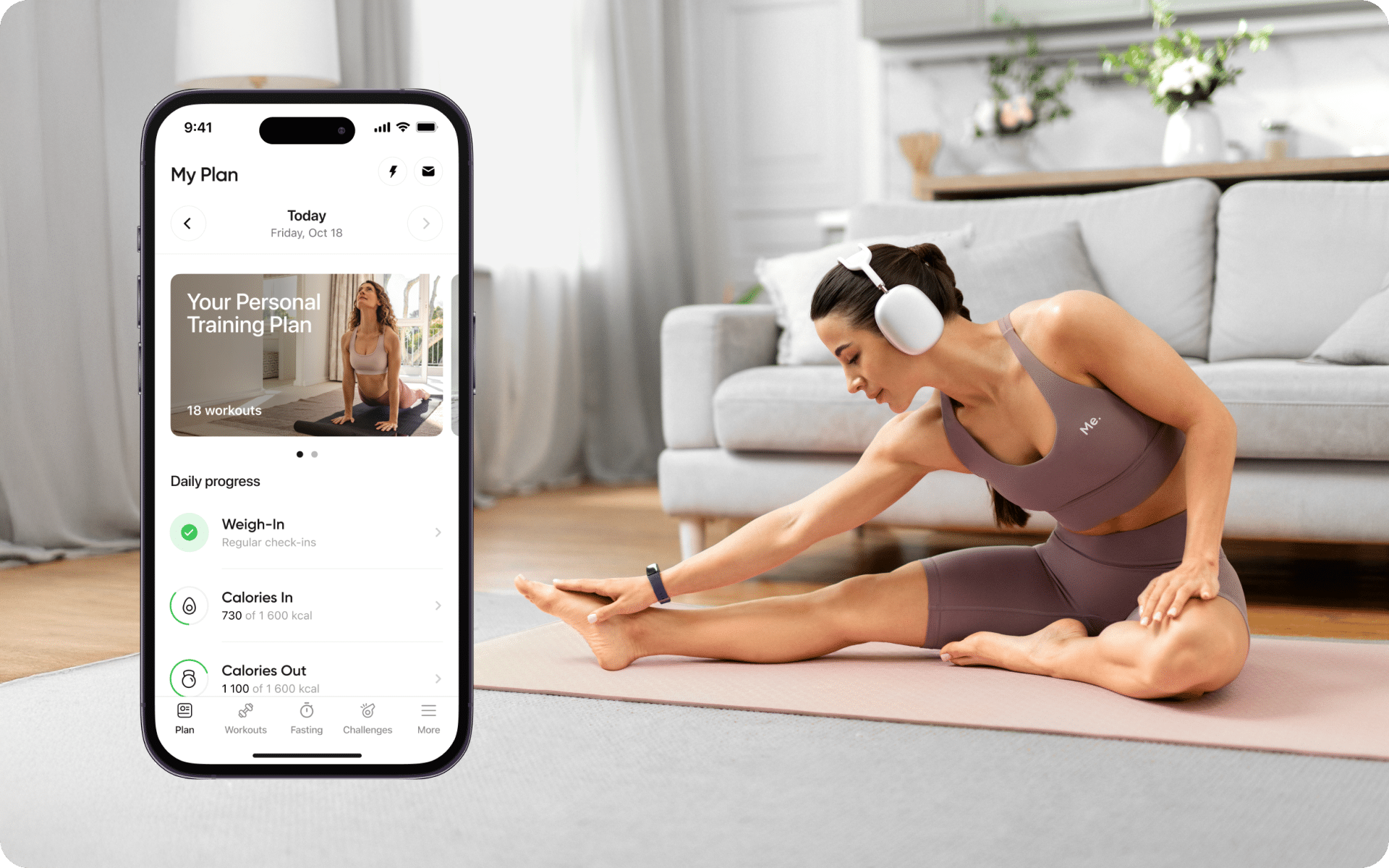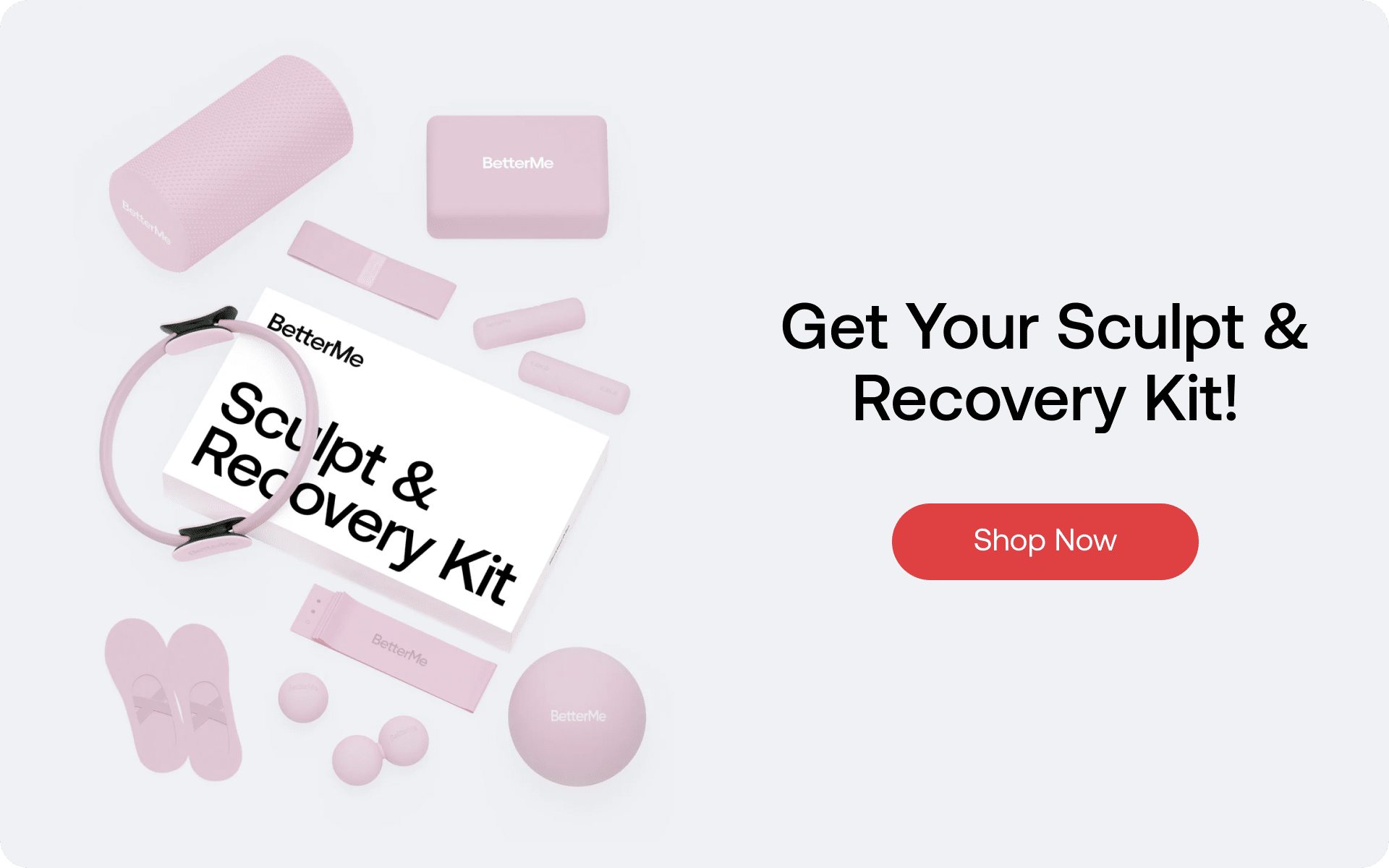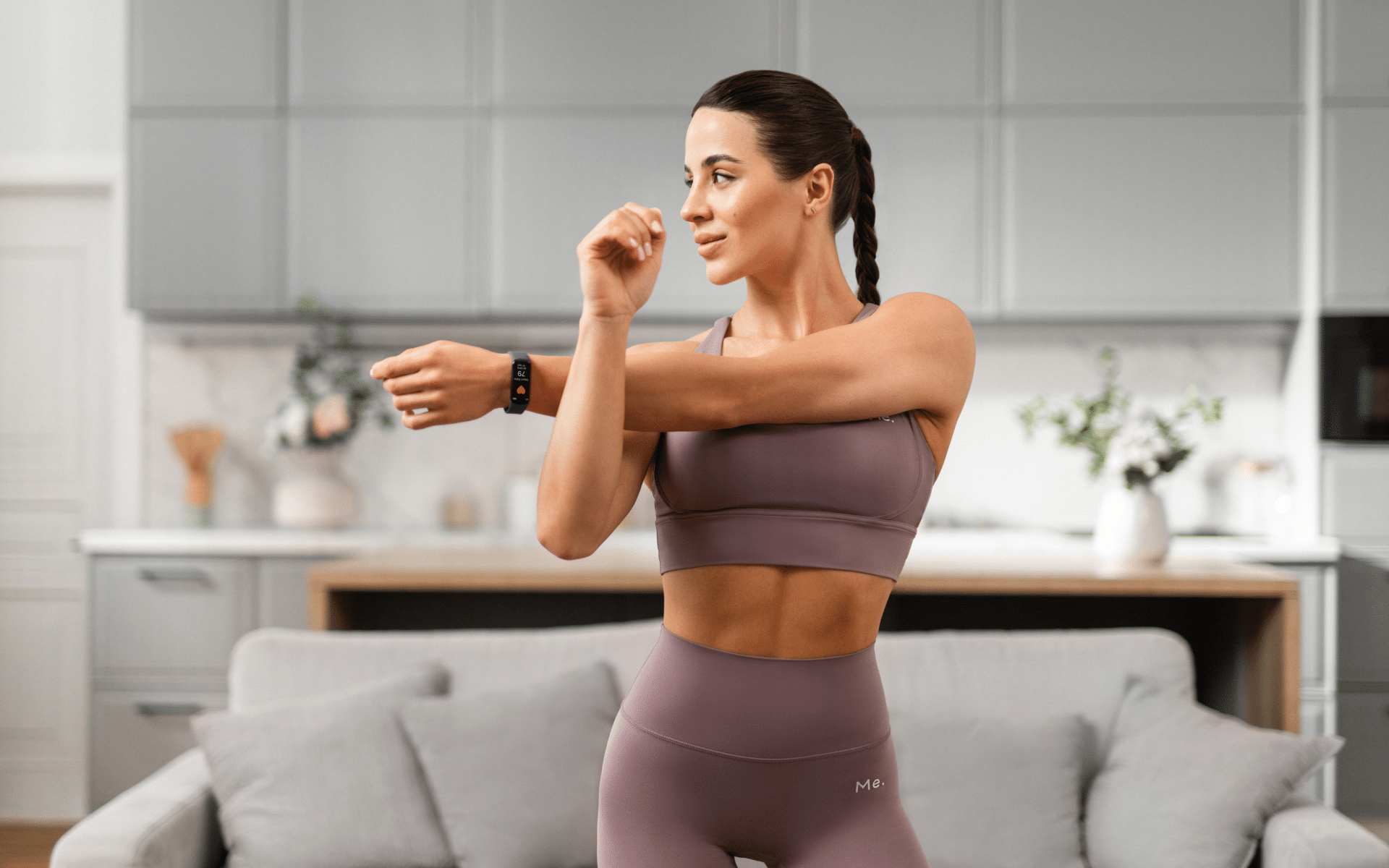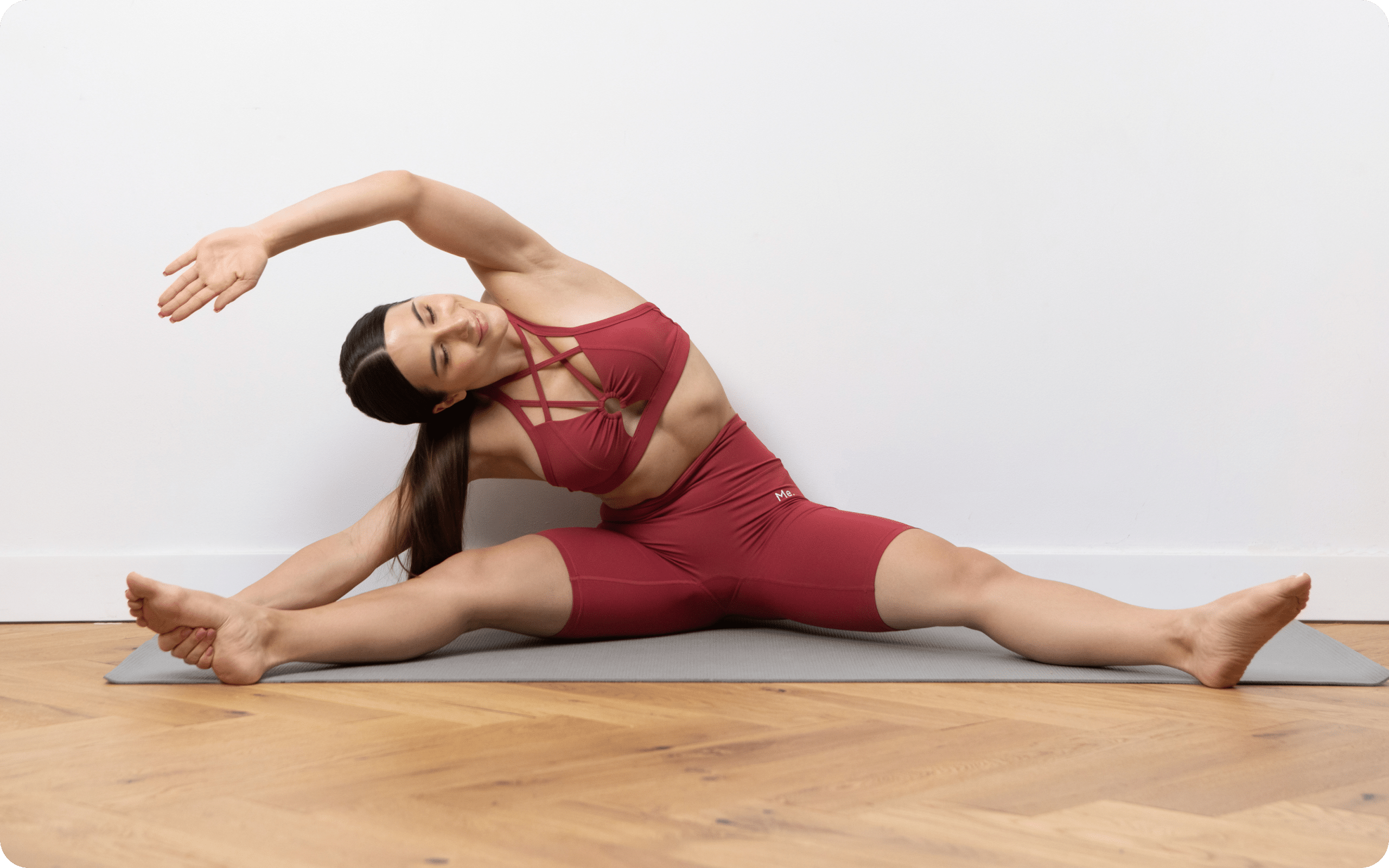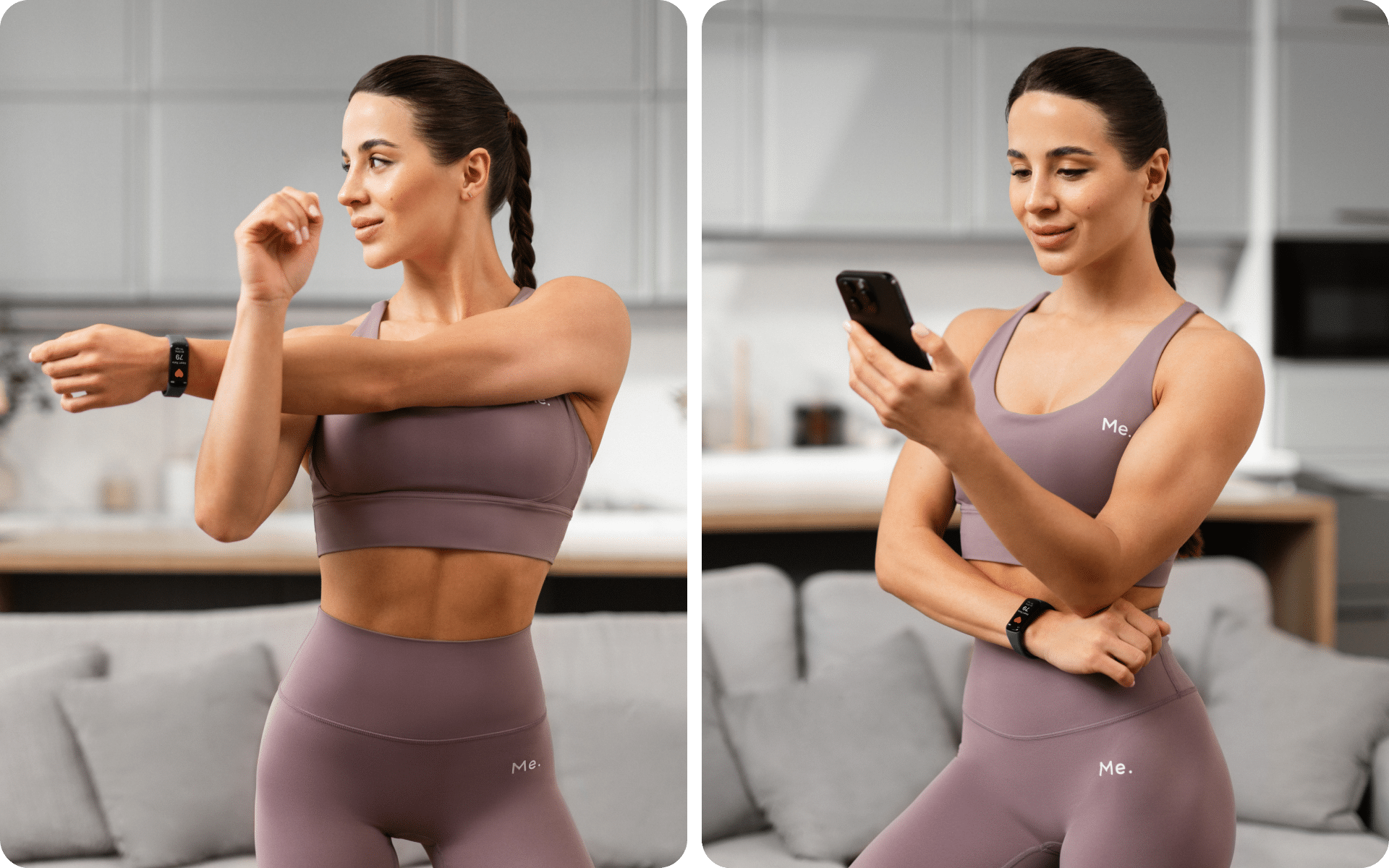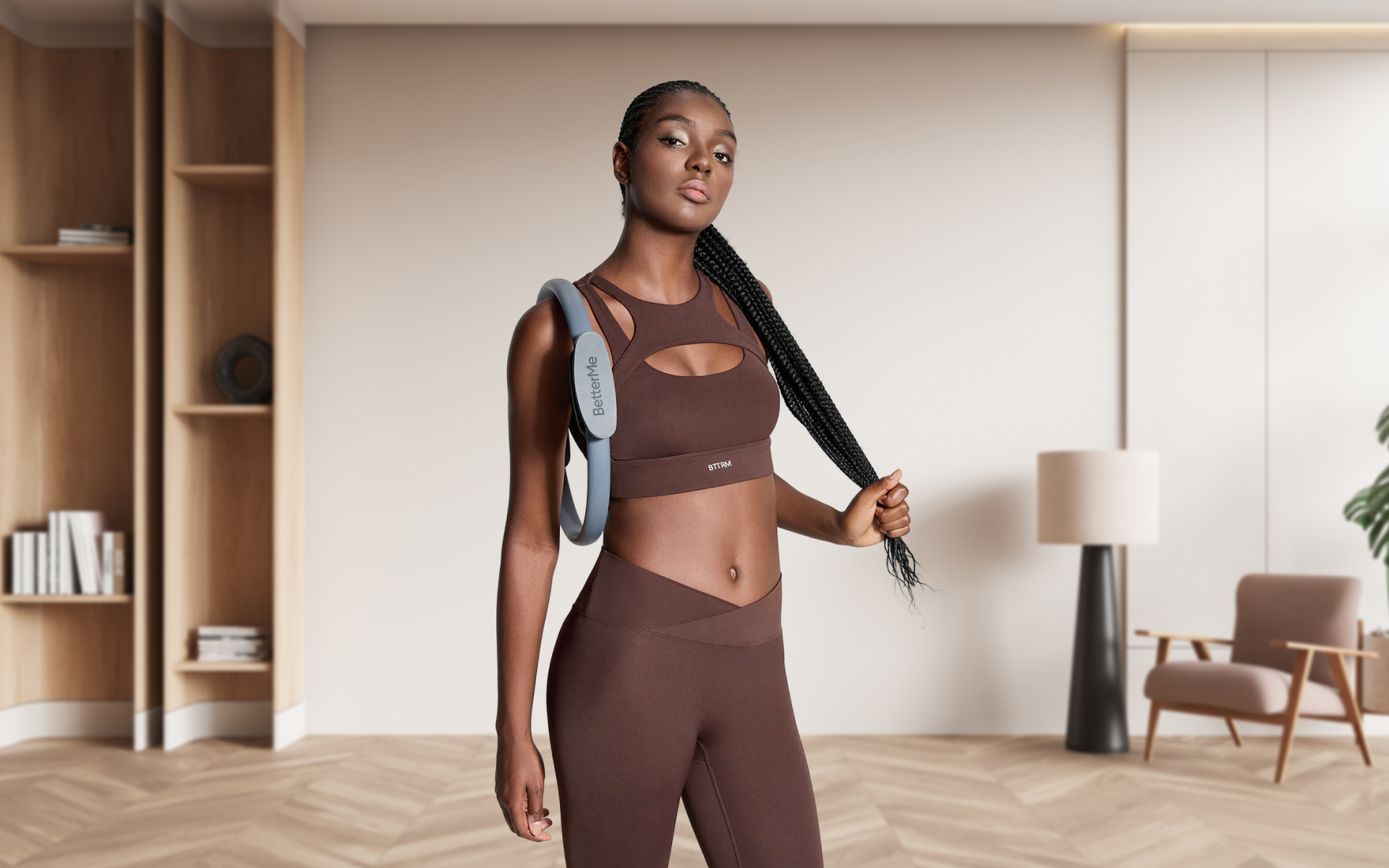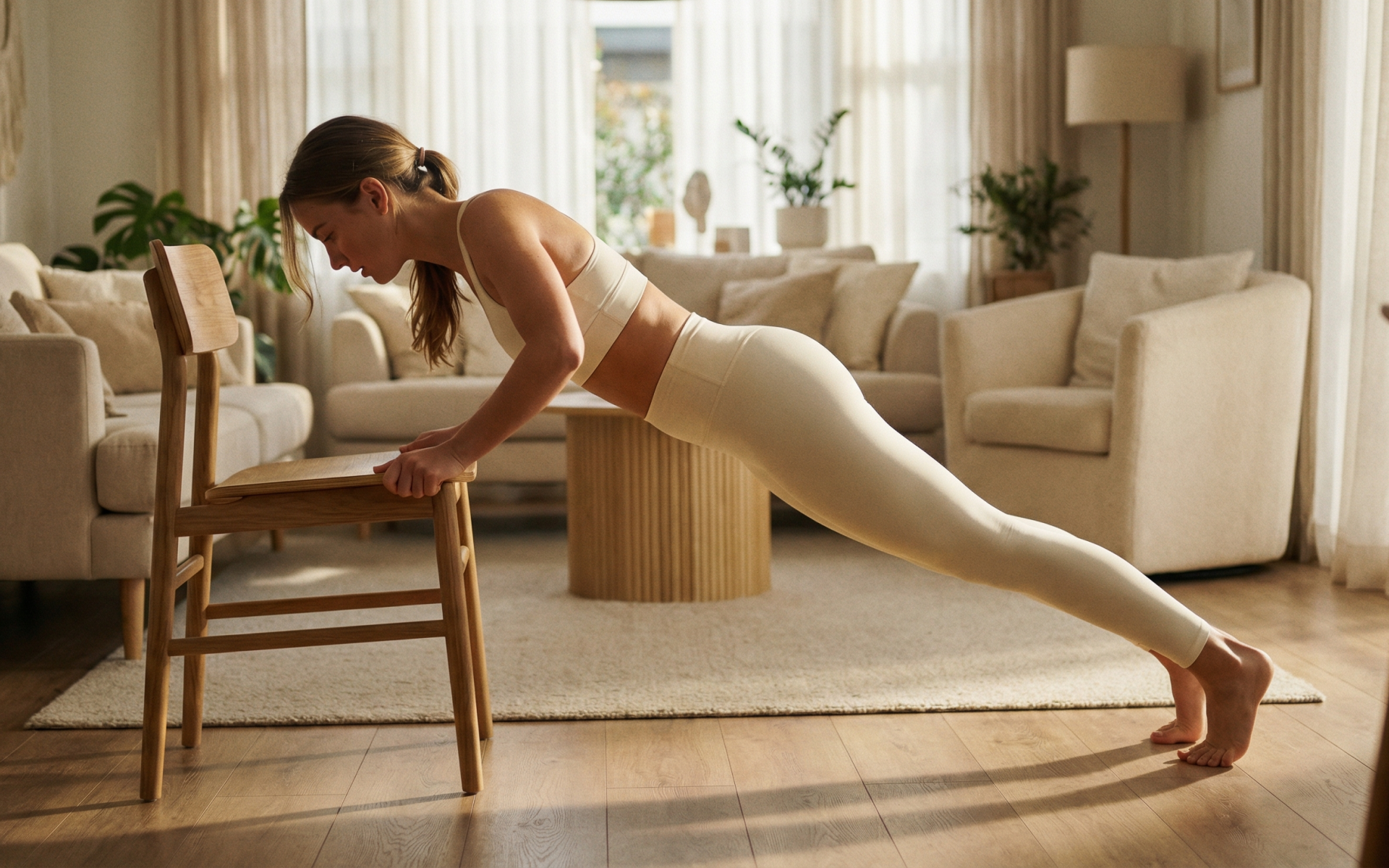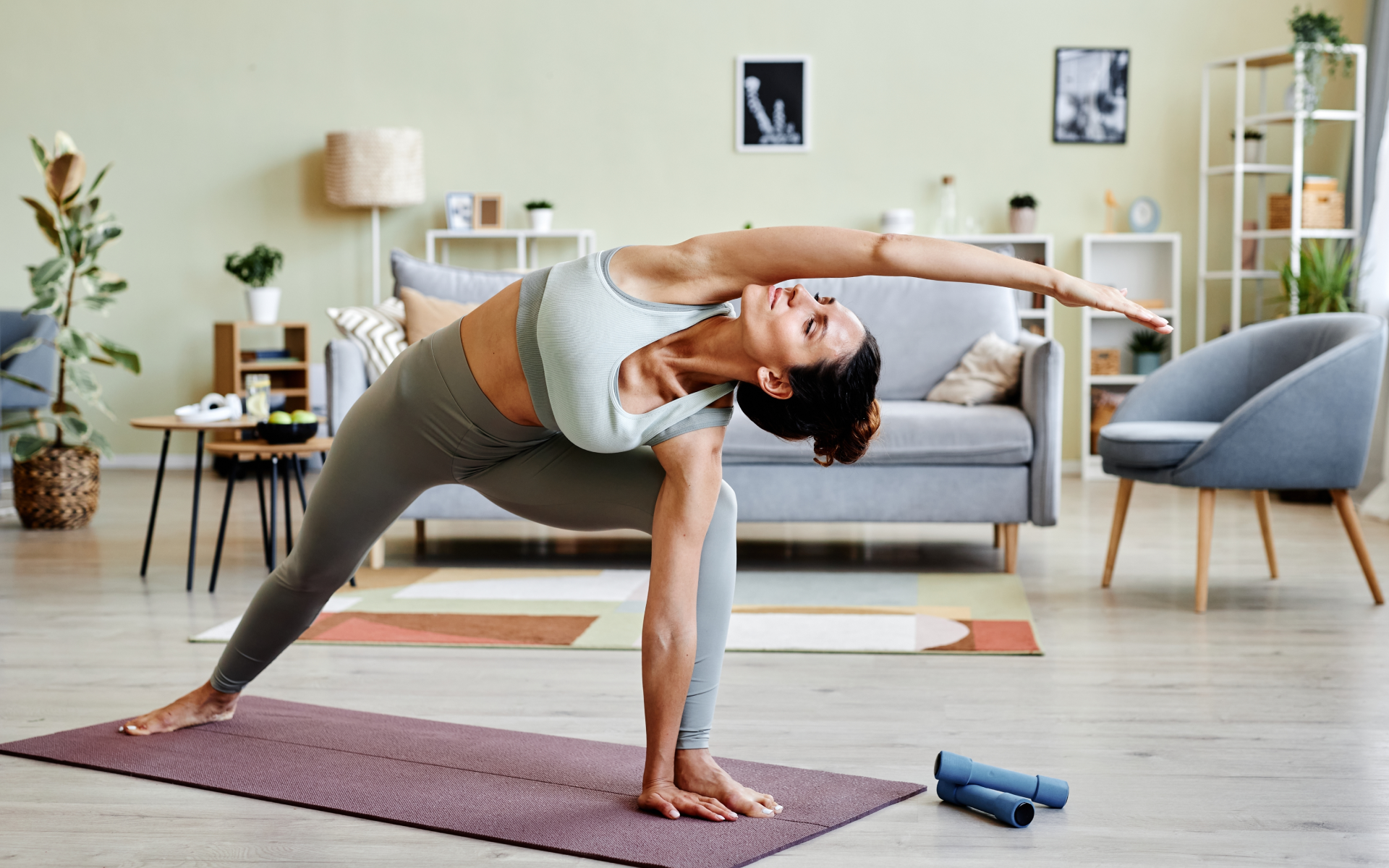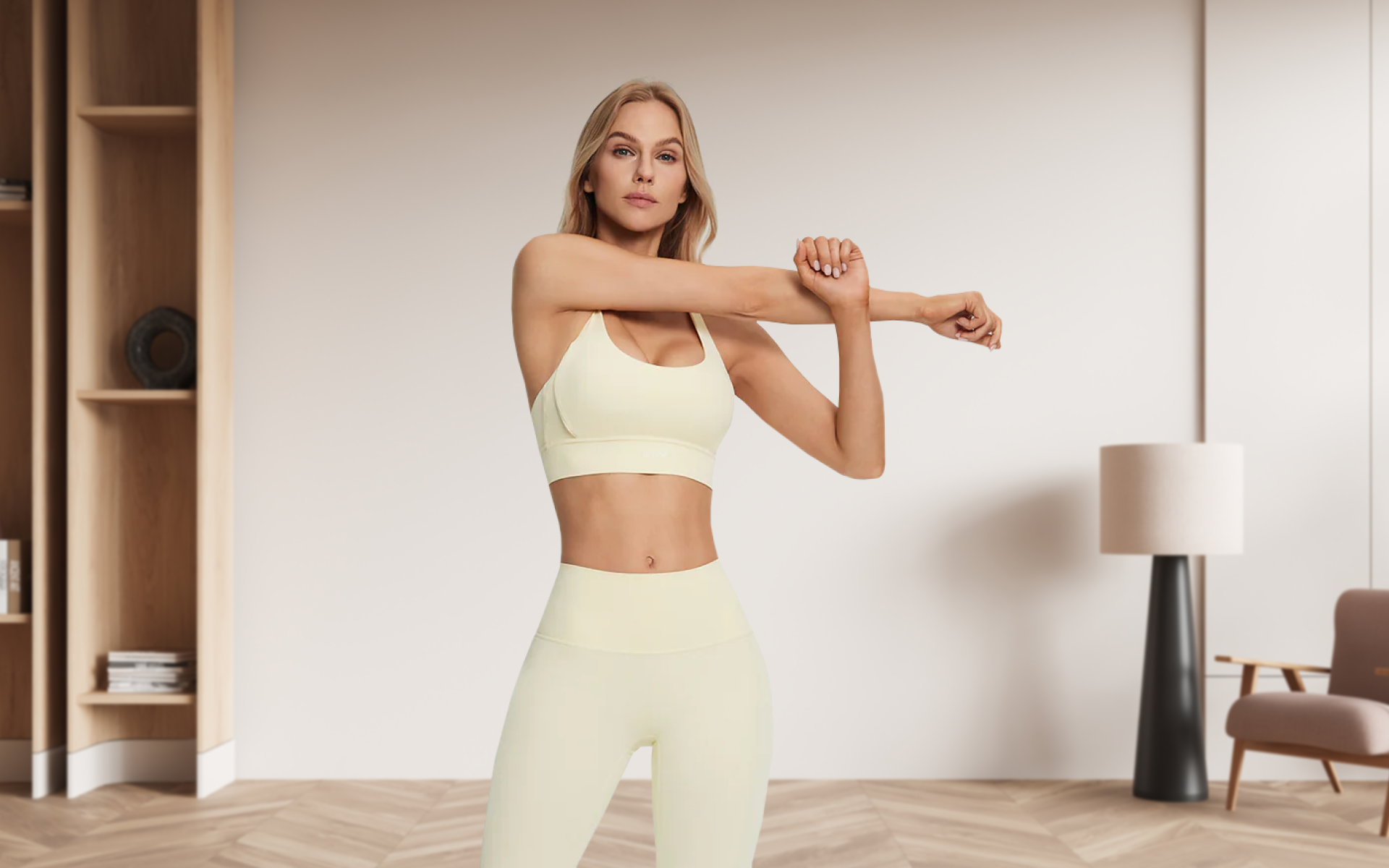Pilates is a popular form of exercise that focuses on strengthening and toning the body through controlled movements. One of the best ways to practice Pilates is by using a wall as a prop. Wall exercises in Pilates not only help strengthen the core, but also improve posture and balance.
The thing about core strength is that it’s not all about having defined abs, and in fact research supports this completely. Having a strong core means having a stable and supportive center that helps you move efficiently and with proper alignment (10).
A strong core can help alleviate back pain, improve athletic performance and prevent injuries (10). With that in mind, whether you’re just starting out with Pilates or looking to add some variety to your routine, here are 6 wall exercises for beginners to try.
What Is The Difference Between Pilates and Wall Pilates?
The main difference between traditional Pilates and wall Pilates is the use of a wall for support and resistance. Traditional Pilates uses specialized equipment like reformers and cadillacs to provide resistance, while wall Pilates primarily utilizes the body’s own weight against the wall for resistance.
Here are the distinct differences between the two:
Traditional Pilates:
- Equipment: Traditional Pilates exercises can be performed on a mat or using specialized equipment like the Reformer, Cadillac, or Wunda Chair.
- Focus: Emphasizes precise movements, controlled breathing, and alignment. It targets the core but also works on overall muscle tone, flexibility, and posture.
- Variations: Includes a wide range of exercises from beginner to advanced levels.
Wall Pilates:
- Equipment: Uses a wall as a prop for performing various exercises. The wall provides resistance and support, which can help increase the effectiveness of the workout.
- Focus: Combines elements of traditional Pilates with isometric exercises (exercises where the muscle length doesn’t change during contraction and remains constant throughout the movement). The wall adds resistance, making certain moves more challenging and beneficial for muscle strengthening and stabilization.
- Suitability: Ideal for people who may need additional support or stability, such as beginners or those recovering from injuries. It also adds variety to a traditional Pilates routine by introducing new angles and forms of resistance.
Both forms aim to improve physical fitness through controlled, mindful movements, but Wall Pilates leverages the wall to modify and potentially enhance the traditional Pilates exercise.
We’ve compiled the perfect pilates workout routine in our, wall pilates routine article.
Is Pilates Wall Workout Effective?
Yes, using a wall in your Pilates workout can be highly effective. The wall provides support and resistance, allowing you to engage your core muscles more deeply, while maintaining proper form. It also adds an element of stability and balance, making the exercises arguably more challenging than a traditional Pilates workout.
In my years of teaching Pilates, I have seen many clients improve their core strength and posture significantly through regular wall exercises.
Let’s review 7 science-backed Pilates wall exercises benefits, in detail. We’ll discuss what the benefit is, why it matters for different groups of people (beginners, seniors, and even those who’ve been lifting weights), as well as what science says.
Dropping pounds by the dozens without putting yourself through the wringer is everyone’s weight loss pipe dream. But what if we told you that the BetterMe app can make that happen? Keep yourself in prime shape with our fat-blasting workouts, delicious budget-sparing recipes, and body-transforming challenges with our app!
Note that wall Pilates isn’t as extensively researched as traditional Pilates, but this article combines evidence from core function studies, with practical application.
1. Enhanced Core Stability
Benefit: Pilates wall exercises significantly enhance core stability by engaging deep abdominal muscles.
Why It Matters: For beginners, building a stable core is foundational to performing more advanced Pilates moves safely. Seniors can benefit immensely as a stable core helps in maintaining balance, reducing the risk of falls. Even those who have been lifting weights find that a strong core aids in lifting heavier and with better form (10).
Science Says: Research on core stability highlights the importance of activating deep core muscles for overall functional movement and injury prevention. Studies show that these muscles are more effectively targeted during controlled, resistance-based movements, such as those performed against a wall (10).
2. Improved Posture
Benefit: Regularly practicing Pilates wall exercises helps to correct posture by strengthening the muscles that support the spine (6).
Why It Matters: Good posture is crucial for everyone but becomes particularly important as we age, helping to prevent the forward hunch, as often seen in seniors (9). Beginners benefit by learning to align their bodies correctly from the start, while regular exercisers can counteract the postural imbalances that often come from other high-impact workouts.
Science Says: Studies in kinesiology demonstrate that exercises focusing on posture correction can significantly reduce back and neck pain, commonly associated with poor posture (9).
3. Enhanced Balance and Coordination
Benefit: Using the wall in Pilates requires maintaining balance and coordination, thereby improving these essential skills over time (6).
Why It Matters: Enhanced balance is particularly beneficial for seniors to prevent falls (5). Beginners gain a sense of body awareness that helps in executing other exercises correctly. Weight lifters can improve their coordination and stability, leading to more efficient and effective workout routines.
Science Says: Research suggests that balance-focused exercises can improve neuromuscular control, leading to the potential for better overall movement patterns and reduced injury risk (5).
4. Increased Flexibility
Benefit: Many Pilates wall exercises incorporate stretching movements that enhance overall flexibility (6).
Why It Matters: Flexibility is critical for improving range of motion and reducing muscle stiffness, which is valuable for people of all ages. This can lead to beginners finding it easier to progress in their fitness journey and seniors can maintain their mobility longer, and even seasoned athletes can prevent injuries and enhance performance (8).
Science Says: Flexibility training has been well-documented to improve muscle elasticity and joint mobility, thus aiding in the prevention of injuries and enhancement of functional movement (8).
5. Reduced Back Pain
Benefit: Strengthening the core and improving posture through wall Pilates often leads to a reduction in back pain (10) (3).
Why It Matters: Chronic back pain is a common issue that affects people irrespective of age and fitness level. Strengthening the core and correcting posture alleviates strain on the back, providing relief and can even improve quality of life (10) (9).
Science Says: Medical studies consistently show that core-strengthening exercises are effective in reducing chronic lower back pain and improving functional ability (10) (3) .
Read more: Wall Pilates for Butt: A Quick Guide for Beginners
6. Greater Mind-Body Connection
Benefit: Pilates emphasizes a strong mind-body connection, and using a wall can heighten this focus by providing additional tactile feedback (7).
Why It Matters: For beginners, engaging both mind and body simultaneously may accelerate learning. Seniors can benefit from the increased mental engagement, which can enhance cognitive function. Experienced practitioners will deepen their practice, with the potential to achieve more precise and mindful movements (7).
Science Says: Neuroscientific research reveals that exercises requiring coordination between mind and body can enhance cognitive function, improving both mental and physical health (4).
7. Versatility and Accessibility
Benefit: Pilates wall exercises are versatile and can be modified to suit any fitness level.
Why It Matters: This makes Pilates wall workouts accessible to a wide range of individuals, from absolute beginners to advanced practitioners. Seniors can adapt the exercises to fit their comfort levels, while those lifting weights can tailor the routines to complement their existing workouts.
Science Says: Studies in exercise adaptability show that customizable routines are more likely to be maintained long-term, thus providing sustained benefits over time (1).
Which Pilates Wall Exercises Should Beginners Use To Improve Core Strength?
Many exercises, performed with the right form will engage the core muscles. However, some of the Pilates wall exercises that beginners can incorporate into their routine to improve core strength include:
1. Wall Roll Down
What Makes It Ideal: The Wall Roll Down is perfect for beginners as it helps in articulating the spine and initiating core engagement gently. It promotes spinal flexibility and elongation.
Muscles Engaged: Primarily engages the rectus abdominis, obliques, and erector spinae.
Benefits: Improves spinal mobility, reduces stiffness, and strengthens abdominal muscles, aiding in everyday movements that require bending and lifting.
Steps to Perform:
- Stand with your back against the wall, feet hip-width apart and slightly away from the wall.
- Inhale deeply, and as you exhale, gently tuck your chin to your chest.
- Slowly roll down one vertebra at a time, keeping your lower back in contact with the wall as long as possible.
- Reach down towards your toes, maintaining a slight bend in the knees if needed.
- Inhale at the bottom, then exhale and reverse the movement, rolling back up slowly.
- Make sure to engage your core throughout the movement for stability.
2. Wall Plank
What Makes It Ideal: The Wall Plank challenges core stability while also engaging the upper body, making it an excellent exercise for overall strength building.
Muscles Engaged: Engages the transverse abdominis, rectus abdominis, deltoids, and triceps.
Benefits: Enhances core strength, shoulder stability, and can improve posture. All which are crucial for both athletic and daily activities.
Steps to Perform:
- Stand facing a wall, arm’s length away, and place your hands flat against the wall at shoulder height.
- Walk your feet back until your body forms a straight line from head to heels.
- Engage your core, keeping your body firm and avoid letting your hips sag or arch excessively.
- Hold the position, maintaining a steady breath for 30 seconds to a minute.
- To increase intensity, try lifting one leg slightly off the ground while maintaining the wall plank.
Want to build an attention-grabbing bubble butt, blast away fat that’s stored in all the wrong places, spring-clean your diet, turn back the clock on your skin, skyrocket your self-confidence and shatter your insecurities? Check out the BetterMe app and set this plan in motion !
3. Wall Teaser
What Makes It Ideal: The Wall Teaser combines flexibility and strength, challenging both the core and the lower body in a dynamic way.
Muscles Engaged: Primarily targets the rectus abdominis and hip flexors.
Benefits: Enhances balance, strengthens the core and hip flexors, and promotes coordination, aiding movements like lifting and bending.
Steps to Perform:
- Sit with your back against the wall, legs extended and slightly apart.
- Extend your arms overhead with fingers pointing towards the ceiling.
- Engage your core, inhale and slowly lift your legs off the ground while rolling your torso away from the wall, striving to form a V shape.
- Reach your arms towards your lifted legs to touch your toes if possible.
- Hold for a few seconds, then slowly lower back to the starting position with control.
- Keep movements smooth and controlled. Try to avoid jerking as this will help to protect the back.
4. Wall Scissors
What Makes It Ideal: Wall Scissors target the lower abdominals and enhance lower body flexibility, making it effective for strengthening the lower core area.
Muscles Engaged: Targets the lower rectus abdominis, hip flexors, and hamstrings.
Benefits: Can improve lower core strength and flexibility, which helps in stabilizing the pelvis and lower back in daily activities.
Steps to Perform:
- Lie on your back with your legs extended up the wall at a 90-degree angle.
- Place your arms beside you or under your hips for added support.
- Engage your core and slowly lower one leg towards the floor while keeping the other leg extended up the wall.
- Alternate legs in a scissoring motion, maintaining control and a steady breath.
- Make sure the lower back stays in contact with the floor to avoid strain.
- Perform 10-15 repetitions, focusing on controlled movements.
5. Wall Bridge
What Makes It Ideal: Wall Bridges will work the entire core along with the glutes and lower back, promoting posterior chain strength.
Muscles Engaged: Targets the glutes, hamstrings, lower back, and abdominals.
Benefits: Strengthens back muscles, enhances glute activation, and stabilizes the hips. These three benefits are all essential for walking, running, and lifting.
Steps to Perform:
- Lie on your back with your feet pressed against the wall, knees bent at 90 degrees.
- Place your arms at your sides for stability.
- Engage your core and glutes, and lift your hips towards the ceiling to form a straight line from knees to shoulders.
- Hold the bridge position for a few seconds, then slowly lower your hips back to the floor.
- Make sure the movement is slow and controlled, focusing on squeezing the glutes at the top of the movement.
- Repeat for 10-15 repetitions.
6. Wall Sits
What Makes It Ideal: Wall Sits are an effective isometric exercise for engaging the core, and they also help improve lower body strength.
Muscles Engaged: Targets the transverse abdominis, rectus abdominis, quadriceps, glutes, and hamstrings.
Benefits: Enhances lower body strength and improves endurance in muscles needed for daily activities like standing and walking.
Steps to Perform:
- Stand facing about a foot away from the wall, with your back straight against the wall.
- Slowly slide down until your knees are bent at a 90-degree angle and thighs parallel to the ground.
- Engage your core muscles and hold the position for 30 seconds to a minute while maintaining steady breaths.
- Make sure your knees are above the ankles, and your back stays in contact with the wall throughout.
- To increase intensity, try lifting one leg off the ground while maintaining the wall sit position.
- Repeat for 3-4 sets.
Find more plans for pilates workouts in our wall pilates plan article.
Is 20 Minutes of Pilates Enough?
20 minutes of Pilates wall exercises at home can make the difference between a sedentary lifestyle and an active one. While ideally, Pilates should be practiced for 30 to 60 minutes daily, even just 20 minutes can provide significant health benefits. For busy individuals or those new to exercise, this shorter time frame makes it easier to incorporate it into their daily routine.
Moreover, the intensity level of a Pilates workout can vary greatly depending on the exercises chosen and effort put in. As such, a 20-minute Pilates session can be just as effective as a longer one if done consistently, intensely and with proper form.
Consider the following factors when deciding the length of your Pilates workouts:
- Fitness goals: Aiming to improve overall fitness and posture may require longer, more intense sessions. However, if the goal is simply to increase flexibility or reduce back pain, shorter sessions can be equally effective.
- Schedule constraints: While everyone should try to prioritize their health and make time for exercise, sometimes life gets in the way. In such cases, a shorter workout is still better than none at all.
- Personal preference: Some individuals may prefer shorter workouts that they can do more frequently, while others may enjoy longer sessions that challenge their endurance. Find what works for you and stick to it.
We recommend that you’re consistent with your practice, listen to your body, and gradually increase the duration or intensity as needed. Remember, any amount of time spent exercising is beneficial for both physical and mental well-being.
Read more: Pilates Full Body Workout for Beginners (No Equipment Needed)
FAQs
Is The 28 Day Wall Pilates Challenge Free?
Yes, the 28 Day Wall Pilates Challenge is often offered for free. Many fitness programs and online platforms provide this challenge at no cost to help individuals kickstart their fitness journey, improve their core strength, and build a consistent workout routine.
Is 20 Minutes Of Pilates Enough To Lose Weight?
While 20 minutes of Pilates can contribute to weight loss, it generally needs to be part of a broader exercise regimen and accompanied by a healthy diet to be effective. Pilates primarily strengthens muscles and improves flexibility, which aids in overall body tone and metabolism. However, for significant weight loss, combining Pilates with cardio exercises and a balanced diet is recommended.
Want to lose that stubborn belly fat? Our, 7 wall exercises for flat stomach blog has the workouts you need.
Will I Lose Weight Doing Pilates?
Yes, you can lose weight by doing Pilates, especially when combined with a healthy diet and regular cardiovascular exercise. Pilates helps build muscle, which in turn increases metabolism and aids in burning more calories throughout the day (2). However, the rate of weight loss may vary depending on factors such as the intensity of the Pilates sessions, frequency, and individual metabolic rates.
What Is The 80 20 Rule In Pilates?
The 80 20 rule in Pilates refers to the balance between effort and relaxation. It suggests that 80% of the effort should be focused on controlled, precise movements, while the remaining 20% should be dedicated to releasing tension and maintaining proper form and breathing. This balance is crucial for maximizing the benefits of Pilates without overstraining the body.
Is Walking Better Than Pilates?
Both walking and Pilates have their unique benefits, and one is not necessarily better than the other; they complement each other well. Walking is a low intensity cardiovascular exercise that helps improve heart health, burn calories, and enhance overall endurance (11).
On the other hand, Pilates focuses on strengthening core muscles, improving flexibility, and promoting better posture (6). Additionally, it tends to be a higher intensity workout in comparison to walking. Combining both activities can provide a well-rounded fitness routine that addresses various aspects of physical health.
The Bottom Line
Beginners can use wall Pilates exercises as a stepping stone towards more advanced Pilates workouts, while seasoned practitioners can use them to target specific muscle groups and add variety to their routines. The exercises we’ve discussed above can help you improve core strength, enhance lower body endurance, and support overall physical well-being when done consistently.
DISCLAIMER:
This article is intended for general informational purposes only and does not serve to address individual circumstances. It is not a substitute for professional advice or help and should not be relied on for making any kind of decision-making. Any action taken as a direct or indirect result of the information in this article is entirely at your own risk and is your sole responsibility.
BetterMe, its content staff, and its medical advisors accept no responsibility for inaccuracies, errors, misstatements, inconsistencies, or omissions and specifically disclaim any liability, loss or risk, personal, professional or otherwise, which may be incurred as a consequence, directly or indirectly, of the use and/or application of any content.
You should always seek the advice of your physician or other qualified health provider with any questions you may have regarding a medical condition or your specific situation. Never disregard professional medical advice or delay seeking it because of BetterMe content. If you suspect or think you may have a medical emergency, call your doctor.
SOURCES:
- A long-term physical activity training program increases strength and flexibility, and improves balance in older adults (2013,researchgate.net)
- Increasing muscle mass to improve metabolism (2013,nih.gov)
- Is Pilates an effective rehabilitation tool? A systematic review (2018,nih.gov)
- Neuroscience of Exercise: From Neurobiology Mechanisms to Mental Health (2013,karger.com)
- Physical activity programs for balance and fall prevention in elderly (2019,nih.gov)
- Pilates – health benefits (2022,betterhealth.vic.gov.au)
- The Impacts of Pilates and Yoga on Health-Promoting Behaviors and Subjective Health Status (2021,nih.gov)
- The Importance of Flexibility and Mobility (n,d,psu.edu)
- The Power of Good Posture (n,d,rush.edu)
- The real-world benefits of strengthening your core (2012,harvard.edu)
- Walking for good health (2023,betterhealth.vic.gov.au)
